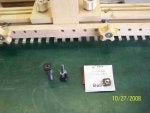subtitles
I'm going to stick my two cents worth in here. All of the above are bang on but I'm going to add the following:
1. clean your surfaces completely. No grease, dust etc.
2. I use a water soluable version of contact cement that is much nicer than the chemical solvent type. The smell is still pretty strong but it is quick and easy to clean up.
4. Work quickly. Get the glue spread evenly then leave it alone! Let it tack up without touching it.
3. Pour a goodly dollup of glue on one of the surfaces and spread with a clean paint roller. I use the 10" roller sleeve. I have some old thin pile ones specifically for this. Repeat with the other surface.
5. Then follow Harry's instructions (minimum 3 dowels) I have a pail full of old sticks just for this purpose. (Keep them clean)
6. Use a "J" roller to press the two parts together to complete the bond. Start in the centre and work out gradually. You're trying to force air bubbles out the edges. I roll, remove a stick and roll some more. Don't remove a stick until it is in the way.
Now, I've tried everything from blocks of wood (with and without wooden mallet), steel blocks, clamps, you name it and I've tried it. Nothing beats the "J" roller. If you don't have one, go get one before you even think about starting.
My biggest headache when applying contact cement is once everything is done, I end up with bumps and other imperfections in the surface of the laminate. I've tracked these down to little bits of contact cement that were disturbed during curing and stuck up above the surface of the remainder of the cement and hardened at a different rate than the rest of the cement. Alternatively, a bit of saw dust with cement around it invariably sticks up and creates a bump in the laminate. Hence my "keep it clean" and "work quickly then don't touch" advice.
BTW, I cut my laminates with a sharp utility knife and a clamped straight edge. Many careful shallow incisions are preferred to a few deep ones.
One last comment. Don't cut the laminate too closely to the final size. Every time I figure that extra piece will just fit, it doesn't. For some reason the more critical the application the more out of line the final application of the laminate is.
Ok, I've tried to help, now I need some help. Can anyone explain what and how to bend laminates? I was doing a kitchen counter with a 1" bullnose edge and for the life of Me, I couldn't get the laminate formed around the edge. I tried heat gun, clothes iron, a piece of iron heated with a propane torch and the whole thing prompted with clamps and any sort of rig with which I could inflict tension.
Your insight into the world of bent laminate would be appreciated.
Allthunbs











